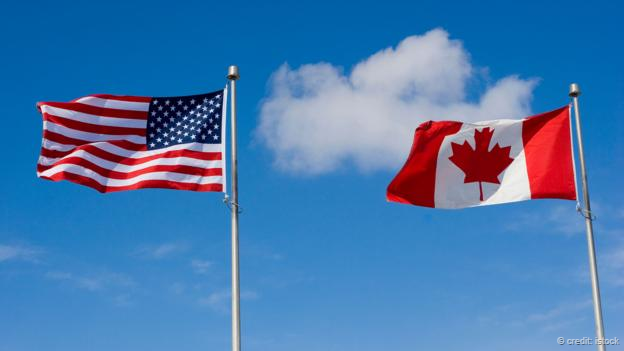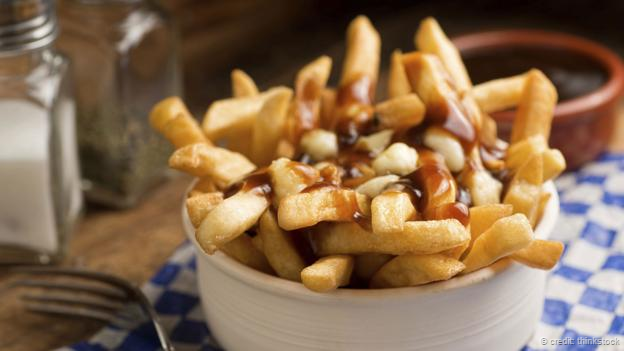加拿大英语为何“不英不美”别具一格?
BBC詹姆斯·哈贝克 (James Harbeck)(2023年8月26日)

(图片来源:iStock)
到底有没有加拿大英语的存在呢?如果有的话,它又是怎样的呢?
在美国人标准的刻板印象里,除了口音不同、说话时喜欢停顿之外,加拿大人和美国人并无二致。然而,多数加拿大人却会告诉你,加拿大英语更接近英式英语,他们会把两国对“colour”与“centre”二词的相同拼写作为佐证。
加拿大英语确实是英语的一个独立分支,在发音和单词上有独特、微妙的区别。它有自己的词典,境内的出版社有专门的风格指导;其编辑协会最近也出版了第二版《加拿大英语编辑》。然而这本书的标志性特征就是其中的美式与英式英语对照表,这样加拿大编辑便可以在每个特定的场合中做出合理的决定、使用适当的表达。
论及加拿大英语的核心,实际上就是一种普遍的矛盾心理。
加拿大的历史有助于我们了解这一说法的原因。起初,这里只有原住民,他们的语言和文化多元丰富程度远超欧洲。现在这些还保留着,但就像以英语为母语的加拿大主流社会一样,加拿大英语对它们产生了不小的影响。欧洲移民之间的战争进一步推动了加拿大英语的形成。
十七世纪初,法国人占领了圣劳伦斯河流域及河流以南的大西洋沿岸地区。到十八世纪中叶,英法交战,1763年在巴黎签署停战条约。巴黎条约规定法国将“新法兰西”殖民地割让给英国,英国则允许任何愿意臣服于英王的法国人继续那里生活。

1777年,美国预先批准并承认加拿大独立,却在第二次独立战争中对该国实施入侵,尽管如此加拿大的文化却始终保持独立(图片来源:iStock)
巴黎条约签署时,加拿大境内并没有多少说英语的人。但美国革命却打破了这一状态。
加拿大的开国鼻祖是以英语为母语、忠于英王的“联合帝国忠实臣民”。美国闹独立时,他们逃到北方,在加拿大得到了封地奖赏。因此,加拿大英语从一开始就有“似美非美”的特色。
说它属于美式英语,是因为说英语的那些人来自于殖民地时期的美国;说它们不是,是因为他们拒绝承认新独立的国家。
忠于王室
独立后的美国竭力寻求一套独具特色、美国版本的英语,而那些帝国忠臣则尽力保持和更贴近英格兰……诸如此类的。这些人的英语已经与英国英语分道扬镳了:当伦敦及周边的居民开始在语言中省略字母“R”、改变一些元音发音的时候,美国部分地区的人们接受了其中的一些改变,但加拿大人却没有。
美国南北战争结束后,美国参议员查尔斯·萨姆纳 (Charles Sumner) 要求英国将加拿大割让给美国,因为英国在战时向南方邦联提供军火与北方作战,需要为此作出赔款。
这导使大量英国人涌入加拿大,并对加国产生了更多影响。第二次独立战争之后,母国英国鼓励更多人移民到加拿大去,以确保对英国的忠诚发扬光大。英国当局和学校老师在拼写和语法上给加拿大英语留下了印记,但他们却没能影响人们的发音。
加拿大人民虽然以英国女王为最高首领,但毕竟美国才是他们的近邻和最大贸易伙伴。英国可能算作亲眷,但美国无疑是朋友。
加拿大英语和整个美洲的英语相差无几。直到十九世纪末期,欧洲人才进入加拿大西部地区。那儿的土地被作为奖励赠予了来自安大略湖的英裔加拿大人,以及来自英国和其他一些国家的移民(例如自1891年以后抵达加拿大的乌克兰移民)。
大西洋沿岸省份的英语拥有更多独特之处,其中1949年才正式成为加拿大省份的纽芬兰岛更是与众不同,去那里的定居者大部分说爱尔兰英语。
如今,五分之一的加拿大人不以英语或法语为母语 — 这个数字几乎跟以法语为母语的人一样多。不过,加拿大英语的基本特点仍旧像一个亲英派的美国大家庭,厨房里有些其他的文化、原住民(曾经是这里唯一的居住者)留下的各种痕迹,还有法国房客带来的影响。
激烈竞争
正如之前提到的那样。加拿大英语的拼写方法是英式与美式英语拼写法之间的激烈角逐 — 既使用美式英语的“jail”和“analyze”,也保留英式英语的“centre”和“colour”。由于加拿大属于双语国家,法语在一定程度上也有影响。举例来说,许多标志、标签和机构名称都用英法双语表示,如果你能用两种语言打出单词,那就轻松多了:购物中心(Shopping Centre d’Achats)。 “五分之一的加拿大人以英语或法语为母语 ”
除了一些细节之外,加拿大的发音听起来很像美国,尤其接近于美国的某些地区。这也就是为何两个国家的公民会因为词汇中莫名的细小差异而感到惊讶的原因。这样的事儿太多了。曾任加拿大牛津词典主编的凯瑟琳·巴伯 (Katherine Barber) 在其著作《Only in Canada, You Say》一书中,就收集了许多带有加拿大英语特色的例子。
有时候,加拿大人和美国人用同样的词,但用法不一样:在加拿大,如果你做了测试(write a test),你是被测试的人,而在美国,你是出测试考卷的人。而有些时候,加拿大人又会用不同的词汇表达同样的事情:garburator和kitchen disposal都表示厨房垃圾, bachelor apartmen和studio apartment都表示一室公寓, runner、sneaker和running shoe都用来指运动鞋。

‘Poutine’系魁北克法语单词,用于表示一种风靡加拿大的快餐小吃,包括炸薯条、干酪凝块和肉汁(图片来源:Thinkstock)
有些单词表示的则是一些美国可能没有的东西:Toque 是一种订做针织帽;“poutine”、“Nanaimo bars”和“butter tarts”是加拿大献给世界的三种上等烹饪礼物,如果世界能够接受的话;而“Caesar”则是用 clamato 汁水(番茄汁及蛤汁混合)制作的鸡尾酒血腥玛丽。一些词还借用自魁北克法语(不适用于法国),比如之前提到的“poutine”,以及表示便利店的“dépanneur”。
这些加拿大英语特色词的存在,就是加拿大文化不同于美国文化的证明。对于加拿大人而言,即便温哥华和旧金山口音差异比旧金山与圣安东尼奥的口音差异还要小得多,保留这些差异是至关重要的。
虽然说英语的加拿大人仍旧臣服于女王,他们未必真的对做英国人或听起来像英式英语感兴趣;他们只是想利用与英国的关联来证明自己独立于独立的美国,而之所以选择离开美国,只因为他们不想留下。这的确是一种矛盾的心理。
Why is Canadian English unique?
The standard stereotype among Americans is that Canadians are like Americans, except they say ‘eh’ a lot and pronounce ‘out and about’ as ‘oot and aboot’. Many Canadians, on the other hand, will tell you that Canadian English is more like British English, and as proof will hold aloft the spellings colour and centre and the name zed for the letter Z.
Canadian does exist as a separate variety of English, with subtly distinctive features of pronunciation and vocabulary. It has its own dictionaries; the Canadian Press has its own style guide; the Editors’ Association of Canada has just released a second edition of Editing Canadian English. But an emblematic feature of Editing Canadian English is comparison tables of American versus British spellings so the Canadian editor can come to a reasonable decision on which to use… on each occasion. The core of Canadian English is a pervasive ambivalence.
"The core of Canadian English is a pervasive ambivalence "
Canadian history helps to explain this. In the beginning there were the indigenous peoples, with far more linguistic and cultural variety than Europe. They’re still there, but Canadian English, like Canadian Anglophone society in general, gives them little more than desultory token nods. Fights between European settlers shaped Canadian English more. The French, starting in the 1600s, colonised the St Lawrence River region and the Atlantic coast south of it. In the mid-1700s, England got into a war with France, concluding with the Treaty of Paris in 1763, which ceded ‘New France’ to England. The English allowed any French to stay who were willing to become subjects of the English King.
At the time of the Treaty of Paris, however, there were very few English speakers in Canada. The American Revolution changed that. The founding English-speaking people of Canada were United Empire Loyalists – people who fled American independence and were rewarded with land in Canada. Thus Canadian English was, from its very beginning, both American – because its speakers had come from the American colonies – and not American, because they rejected the newly independent nation.
Loyal to the Crown
Just as the Americans sought to have a truly distinct, independent American version of English, the loyalists sought to remain more like England… sort of. These were people whose variety of English was already diverging from the British and vice versa: when the residents of London and its environs began to drop their r’s and change some of their vowels people in certain parts of the United States adopted some of these changes, but Canadians did not.
There did end up being more British influx and influence in Canada. After the War of 1812, Mother England encouraged emigration to Canada to ensure that loyal sentiments prevailed. The accent did not become British, though British schoolteachers and authorities did leave their marks on spelling and grammar. Canadians are indeed subjects of the Queen, but they are also neighbours – and the greatest trading partners – of the United States. The British may be family, but Americans are friends. Or sometimes ‘frenemies’.
Canadian English varies only a little across most of the continent. The Canadian west was not much settled by Europeans until the late 1800s, when land incentives were given to Anglo-Canadians from Ontario and to immigrants from Britain and some other countries (for example, Ukraine, from where immigrants began arriving in Canada in 1891). There are more distinctions in the Atlantic coast provinces, but especially in Newfoundland, which had been settled by Irish English-speakers and was not officially a province of Canada until 1949.
Today, one-fifth of Canadians have a mother tongue other than English or French – nearly as many as have French as their mother tongue. And yet the basic character of Canadian English still appears like a household of Anglophile Americans, with bits from other cultures mainly in the kitchen, a few traces of the indigenous cultures who used to be the only occupants, and some influence from the French roommate.
‘Oot and aboot’
Canadian spelling is, as mentioned, a tug-of-war between the British and the Americans – jail but centre, analyze but colour. Because Canada is bilingual, French may also have an effect. For example, many signs and labels and institutional names are in French and English, and it’s easier if you can press a word into double service: Shopping Centre d’Achats.
"Most Canadians will tell you they don’t say ‘eh’ much "
Also possibly influenced by French is the Canadian eh. French Canadians use hein (also colloquially spelled han) in most of the same kinds of places English Canadians use eh, and they use it more. The eh of Canadian English is not a Canadian invention; it is used in England and elsewhere, but it is used in more different ways in Canada, notably as an emphatic and to maintain conversational involvement: No kidding, eh; Thanks, eh; So I was going to the store, eh, and this guy cut me off. The truth of it is, though, that most Canadians will tell you they don’t say “eh” much, and it is more associated with less-educated speech.
The Canadian accent – or accents, since there is a bit of variation across the country (and much more in Newfoundland) and a larger amount across socioeconomic levels – has a few signal features, and they, too, trace partly to the US and partly to Britain. The best-known feature is ‘Canadian raising’, which affects two specific diphthongs before voiceless consonants: the first part of the diphthong is higher in ice and out than it is in eyes and loud. The out raising makes the vowel sound more like ‘oot’ to American ears. This feature is present across much but not all of Canada. It may be influenced by Scottish English (many British emigres were Scots), or it may be a relic of Shakespeare-era pronunciation.
Another feature is the ‘low back merger’, which makes caught and cot sound the same. Following on this is what is called the “Canadian vowel shift”, whereby bit sounds a bit like bet, bet sounds a bit like bat, and bat is said a bit farther back in the mouth. This shift is still in progress. These changes seem to have originated in Canada, though similar patterns can be seen in some parts of the US.
Happy ‘May two-four weekend’!
Beyond these details, Canadians tend to sound like Americans, especially depending on where the Americans are from. This is why citizens of each country can be blindsided by the unexpected differences peppered throughout the vocabulary. There are many. Katherine Barber, former editor-in-chief of the Canadian Oxford Dictionary, has collected many signature Canadianisms in her book Only in Canada, You Say.
Sometimes Canadians use the same words as Americans in different ways: in Canada, if you write a test, you’re the one being tested, while in the US you’re the test maker. Sometimes Canadians use different words for the same things: garburator for kitchen disposal, bachelor apartment for studio apartment, runner for sneaker or running shoe, two-four for a case of 24 bottles or cans of beer (the uniquely Canadian holiday Victoria Day, which occurs on a Monday near 24 May, is called the ‘May two-four weekend’ in reference to this).
Some words refer to things Americans don’t seem to have: toque for a kind of fitted knitted hat; poutine, Nanaimo bars, and butter tarts for three of Canada’s great culinary gifts to the world if the world would but accept them; Caesar for a bloody Mary made with clamato juice (tomato plus clam). There are hockey metaphors, of course, like deking someone out and stickhandling a problem. There are occasional borrowings from Quebec French (unrecognisable in France) such as the aforementioned poutine, and dépanneur for a convenience store.
These Canadianisms stand as evidence of the difference between Canadian and American culture. It is very important for Canadians to maintain that difference, even if people from Vancouver sound more like people from San Francisco than people from San Francisco sound like people from San Antonio. Though English-speaking Canadians remain loyal to the Queen, they aren’t truly interested in being British or sounding British; they’re just interested in using the British connection to assert their independence from the independent United States, which they left because they didn’t want to leave. An ambivalent situation indeed.